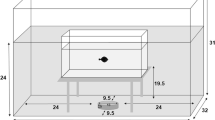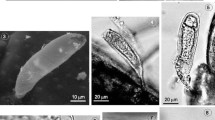Abstract
Trap experiments were conducted using wild and artificially reared juvenile Japanese flounder in various conditions as baits in a flounder nursery habitat of Mano Bay. All of the live wild flounder placed in the traps with sand survived in good health. However, most of the live wild flounder in the traps without sand and live-reared flounder in the traps with and without sand, as well as injured and dead-reared flounder, were consumed and stripped to skeletons overnight. A large number of the lysianassoid Orchomene sp. and Orchomene naikaiensis, and the cypridinid Vargula hilgendorfii, which are typical scavengers, accumulated in the traps with consumed flounder; however, few amphipods and ostracods occurred in traps without consumed flounder. Thus, once flounder are detected and reached by a swarm of these crustaceans, flounder may be preyed on, irrespective of the condition of the fish. This finding is supported by aquarium observations that amphipods and ostracods were able to kill and consume live flounder. Burial in sand will potentially prevent the crustaceans from detecting wild flounder by interfering with the odor from the fish. The results of our study raise the possibility that scavenging crustaceans are able to predate hatchery-reared flounder released in the sea.


Similar content being viewed by others
References
Sekiguchi H, Yamaguchi Y (1983) Scavenging gammaridean amphipods from the deep-sea floor. Bull Fac Fish Mie Univ 10:1–14
Sainte-Marie B (1992) Foraging of scavenging deep-sea lysianassoid amphipods. In: Rowe GT, Pariente V (eds) Deep-sea food chains and the global carbon cycle. Kluwer Academic Publishers, Netherland, pp 105–124
Dauby P, Scailteur Y, Broyer CD (2001) Trophic diversity within the eastern Weddell Sea amphipod community. Hydrobiologia 443:69–86
Legeżyńska J (2001) Distribution patterns and feeding strategies of lysianassoid amphipods in shallow waters of an Arctic fjord. Pol Polar Res 22:173–186
Wilkinson I, Wilby P, Willians P, Siveter D, Vannier J (2007) Ostracod carnivory through time. In: Elewa AMT (ed) Predation in organisms: a distinct phenomenon. Springer-Verlag, Berlin, pp 39–57
Nygård H, Berge J, Søreide JE, Vihtakari M, Falk-Petersen S (2012) The amphipod scavenging guild in two Arctic fjords: seasonal variations, abundance and trophic interactions. Aquat Biol 14:247–264
Sainte-Marie B, Lamarche G (1985) The diets of six species of the carrion-feeding lysianassid amphipod genus Anonyx and their relation with morphology and swimming behavior. Sarsia 70:119–126
Vannier J, Abe K, Ikuta K (1998) Feeding in myodocopid ostracods: functional morphology and laboratory observations from videos. Mar Biol 132:391–408
Stepien CA, Brusca RC (1985) Nocturnal attacks on nearshore fishes in southern California by crustacean zooplankton. Mar Ecol Prog Ser 25:91–105
Tamburri MN, Barry JP (1999) Adaptations for scavenging by three diverse bathyal species, Eptatretus stouti, Neptunea amianta and Orchomene obtusus. Deep-Sea Res I 46:2079–2093
Ide K, Takahashi K, Sasaki K, Omori M (2006) Predation by scavenging amphipods to injured hatchery-raised juvenile Japanese flounder Paralichthys olivaceus under laboratory conditions. Fish Sci 72:1209–1214
Sudo H, Ikemoto R, Tomiyama M, Azeta M (1992) Mortality of reared flounder (Paralichthys olivaceous) juveniles released in Shijiki Bay. Bull Seikai Natl Fish Res Inst 70:29–37 (in Japanese with English abstract)
Furuta S, Watanabe T, Yamada H (1998) Predation by fishes on hatchery-reared Japanese flounder Paralichthys olivaceus juveniles released in the coastal area of Tottori Prefecture. Nippon Suisan Gakkaishi 64:1–7 (in Japanese with English abstract)
Sudo H, Kajihara N, Fujii T (2008) Predation by the swimming crab Charybdis japonica and piscivorous fishes: a mortality factor in hatchery-reared juvenile Japanese flounder Paralichthys olivaceus released in Mano Bay, Sado Island, Japan. Fish Res 89:49–56
Tanaka M, Goto T, Tommiyama M, Sudo H (1989) Immigration, settlement and mortality of flounder (Paralichthys olivaceus) larvae and juveniles in a nursery ground, Shijiki Bay, Japan. Neth J Sea Res 24:57–67
Yamashita Y, Yamamoto K, Nagahora S, Igarashi K, Ishikawa Y, Sakuma O, Yamada H, Nakamoto Y (1993) Predation by fishes on hatchery-raised Japanese flounder, Paralichthys olivaceus, fry in coastal waters of Iwate Prefecture, northeastern Japan. Suisan Zoshoku 41:497–505 (in Japanese with English abstract)
Saito K, Takagaki M, Yamashita Y (2003) Detection of Japanese flounder specific DNA from gut contents of potential predators in the field. Fish Sci 69:473–477
Tomiyama T, Ebe K, Kawata G, Fujii T (2008) Post-release predation on hatchery-reared Japanese flounder Paralichthys olivaceus in the coast of Fukushima, Japan. J Fish Biol 75:2629–2641
Sudo H, Kajihara N (2008) Food habits of juvenile devil stingers Inimicus japonicus and their changes with growth in the Zostera marina seagrass bed in Mano Bay, Sado Island. Nippon Suisan Gakkaishi 74:827–831 (in Japanese with English abstract)
Hirota Y, Tominaga O, Kamiharako T, Kodama K, Sadakata T, Tanaka M, Furuta S, Kojima K, Koshiishi Y (1989) Geographical distribution of mysids in shallow waters of the Japan Sea. Contrib Fish Res Jpn Sea Block 15:43–57 (in Japanese)
Sudo H, Kajihara N, Noguchi M (2011) Life history and production of the mysid Orientomysis robusta: high P/B ratio in a shallow warm-temperate habitat of the Sea of Japan. Mar Biol 158:1537–1549
Moore PG (1994) Observation on the behaviour of the scavenging lysianassoid Orchomene zschaui (Crustacea: Amphipoda) from South Georgia (South Atlantic). Mar Ecol Prog Ser 113:29–38
Moore PG, Wong YM (1995) Activity and trapping characteristics in the field of Orchomene nanus (Krøyer) (Amphipoda: Lysianassoidea) at Millport, Scotland. J Exp Mar Biol Ecol 189:143–157
Vannier J, Abe K (1993) Functional morphology and behavior of Vargula hilgendorfii (Ostracoda: Myodocopida) from Japan, and discussion of its crustacean ectoparasites: preliminary results from video recordings. J Crust Biol 13:51–76
Kaufmann RS (1994) Structure and function of chemoreceptors in scavenging lysianassoid amphipods. J Crust Biol 14:54–71
Premke K, Muyakshin S, Klages M, Wegner J (2003) Evidence for long-range chemoreceptive tracking of food odour in deep-sea scavengers by scanning sonar data. J Exp Mar Biol Ecol 285–286:283–294
Ide K, Takahashi K, Omori M (2007) Direct observation of swimming behavior in a shallow-water scavenging amphipod Scopelocheirus onagawae in relation to chemoreceptive foraging. J Exp Mar Biol Ecol 340:70–79
Meador JP (1989) Chemoreception in a lysianassid amphipod: the chemicals that initiate food-searching behavior. Mar Behav Physiol 14:65–80
Ide K, Takahashi K, Nakano T, Sato M, Omori M (2006) Chemoreceptive foraging in a shallow-water scavenging lysianassid amphipods: role of amino acids in the location of carrion in Scopelocheirus onagawae. Mar Ecol Prog Ser 317:193–202
Sainte-Marie B (1986) Effect of bait size and sampling time on the attraction of the lysianassid amphipods Anonyx sarsi Steel and Brunel and Orchomenella pinguis (Boeck). J Exp Mar Biol Ecol 99:63–77
Sainte-Marie B (1986) Feeding and swimming of lysianassid amphipods in a shallow cold-water bay. Mar Biol 91:219–229
Smith KL Jr, Baldwin RJ (1982) Scavenging deep-sea amphipods: effects of food odor on oxygen consumption and a proposed metabolic strategy. Mar Biol 68:287–298
Hessler RR, Ingram CL, Yayanos AA, Burnett BR (1978) Scavenging amphipods from the floor of the Philippine Trench. Deep-Sea Res 25:1029–1047
Acknowledgements
We thank T. Ito, H. Ebina, and the staff of the Sado station of Niigata Prefectural Fisheries and Marine Research Institute for providing hatchery-reared juvenile Japanese flounder; K. Honma for his assistance in field collections; M. Noguchi for providing facilities for laboratory experiments; and Y. Tanaka for providing information on his night dives. This work was supported by a grant from the Fisheries Research Agency (FRA) and the Japan International Research Center for Agricultural Sciences (JIRCAS).
Author information
Authors and Affiliations
Corresponding author
Rights and permissions
About this article
Cite this article
Sudo, H., Kajihara, N. Mortality of juvenile Japanese flounder Paralichthys olivaceus caused by scavenging amphipods and ostracods in trap experiments. Fish Sci 81, 301–308 (2015). https://doi.org/10.1007/s12562-014-0848-1
Received:
Accepted:
Published:
Issue Date:
DOI: https://doi.org/10.1007/s12562-014-0848-1




